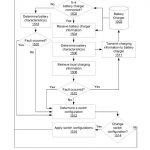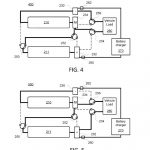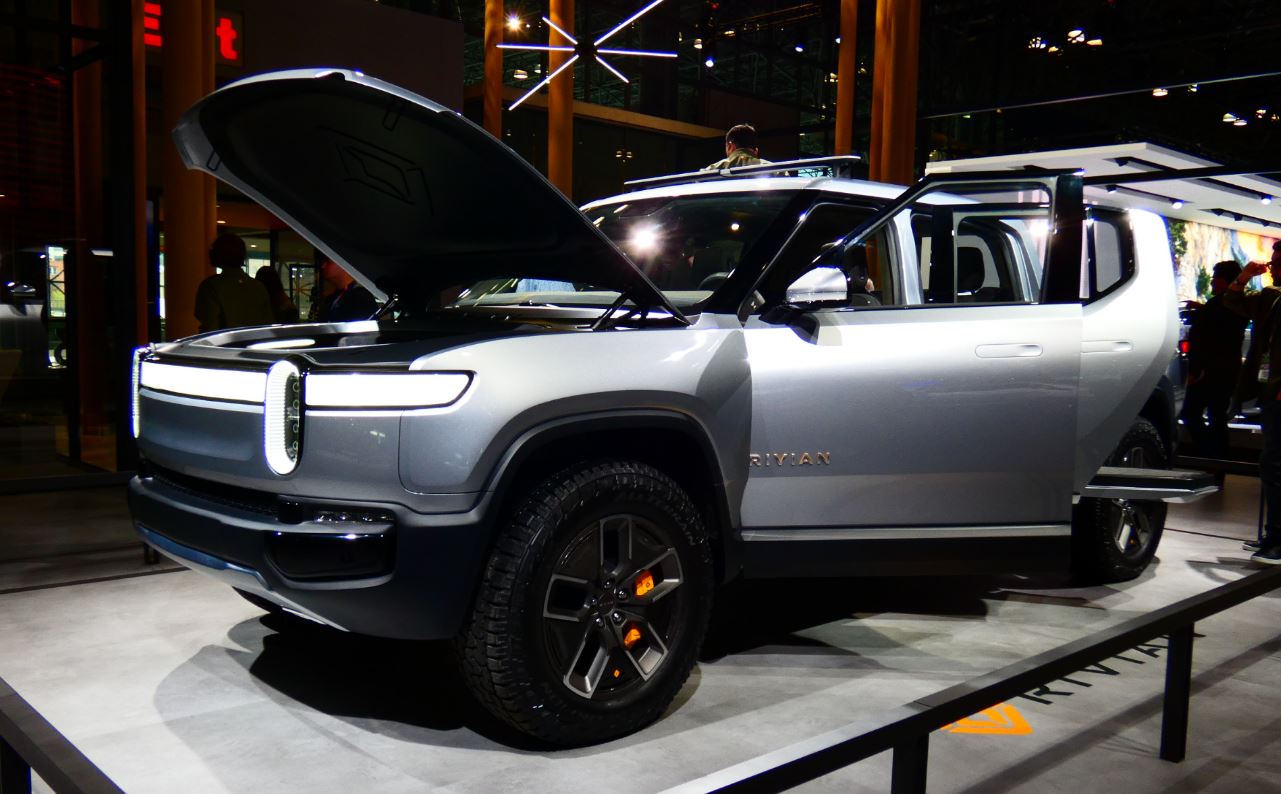
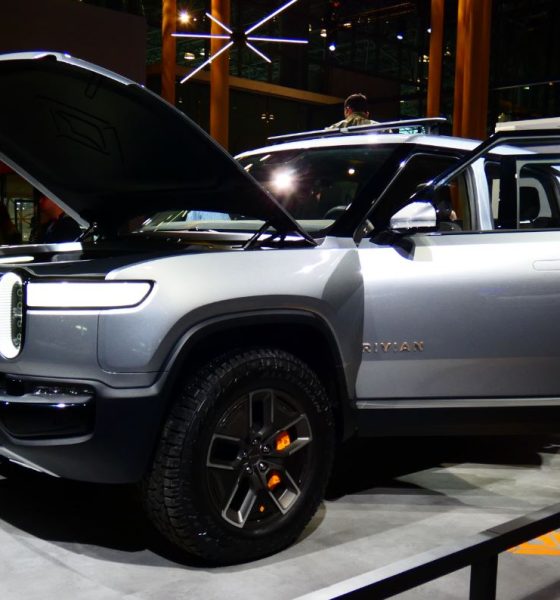
News
Rivian patent application hints at 900V fast charging capabilities
A recently published Rivian patent application titled “Configurable Battery Pack for Fast Charge” describes a method of switching between battery pack connection types to allow for both 450V and 900V fast charging without the need for specialized components. The invention was filed in both the US and internationally, and both applications just published today as US Patent Publication No. 2019/0126761 A1 and International Publication No. WO/2019/084507 A1.
Rivian’s application sets out to solve three specific issues with electric vehicle battery charging. First, increases in charging rates typically require more expensive parts that are rated for the higher current requirements. Second, electronic devices operated while a battery is charging may be impacted via increased voltage when a battery’s charging rate is increased. Finally, when a fault occurs in a battery module, a battery system often needs to be completely disconnected from any loads or the charging voltage must be changed.
The basic concept of the application purports to solve the above-referenced problems. As described, the invention claims that battery modules connected in parallel achieve a targeted maximum high voltage for an electric load (such as 450V), but when connected in series that voltage can be doubled (900V). Details of why this is advantageous are explained in the application as follows:
“A configurable battery system allows the techniques of [this invention] to be applied to an electric vehicle…to more fully utilize a battery charger’s potential [where] it is desirable to achieve a particular charging target. For example, a charging target of 150 kW at 450 V may require a current of 334 A…[and] components may need to be sourced to handle up to 400 A continuously to handle the charging….If a battery system were able to take advantage of charging at 900 V, the charging target of 150 kW could be achieved at just 167 A, which may allow for more numerous, better quality, or cheaper options for charging components. For example, a current of 167 A may allow different hardware to be used than if the current were nearer to 400 A.“
- Figure from Rivian’s battery connection switching patent application. | Image: Rivian/USPTO
- Figure from Rivian’s battery connection switching patent application. | Image: Rivian/USPTO
- Figure from Rivian’s battery connection switching patent application. | Image: Rivian/USPTO
The application also includes a battery management system to determine which connection should be used at a given point and switch the connection type accordingly. This same management system is also used to detect faults in the system while charging and use the switching capability to handle them accordingly rather than disconnecting any battery loads.
The US application for this invention was filed June 8, 2018 and thus has not yet been examined. However, in the international version, an examiner has already searched for related inventions based on the first 10 claims of Rivian’s application. These claims only describe “a configurable battery system in which connection of two batteries can be switched between a series and a parallel connection”, which is not considered novel on its own.
This kind of finding is not uncommon for applications undergoing the international filing process and will be further addressed once filed in specific countries. Three other inventions were determined to be present in the application which will likely be incorporated with the first ten as the invention’s proceedings continue.

Rivian aims to be the leading expert on battery technology, and patent applications such as this one are a nod towards that innovation goal. The Michigan-based all-electric car maker runs a battery lab in Irvine, California where it has picked up several engineers from renowned supercar brand McLaren. This talent pool includes hypercar engineer Richard Farquhar who is their VP of Propulsion, leading Rivian’s battery and powertrain development.
Currently, each Rivian battery module holds 864 cells, stacked evenly on top of one another, with a thin 7mm aluminum plate with liquid coolant in between. In addition to connection testing, the company uses machine learning to adjust battery cell settings to build predictive models and tune the cells based on situations that may be encountered, such as weather conditions.
Altogether, Rivian’s aim to achieve a level of battery technology that’s reliable and optimal for the electric outdoor adventure branding it has embraced looks to be moving in a promising direction.

News
Tesla’s most affordable car is coming to the Netherlands
The trim is expected to launch at €36,990, making it the most affordable Model 3 the Dutch market has seen in years.
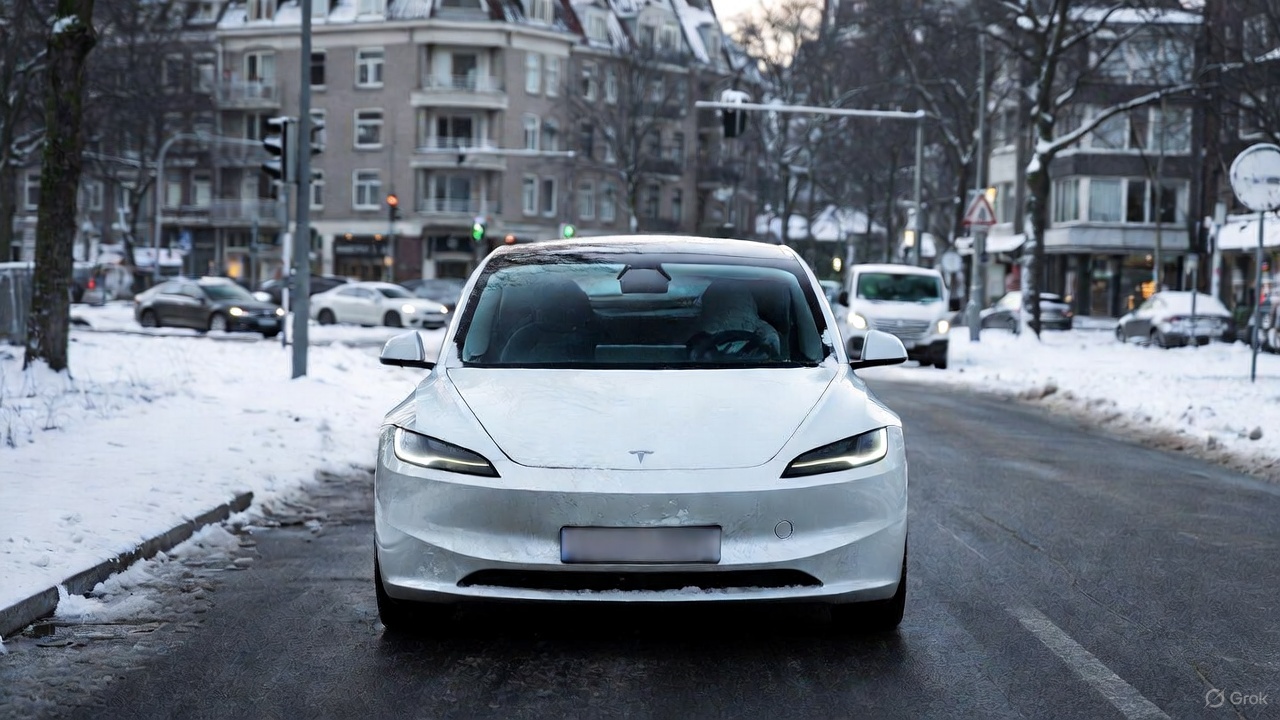
Tesla is preparing to introduce the Model 3 Standard to the Netherlands this December, as per information obtained by AutoWeek. The trim is expected to launch at €36,990, making it the most affordable Model 3 the Dutch market has seen in years.
While Tesla has not formally confirmed the vehicle’s arrival, pricing reportedly comes from a reliable source, the publication noted.
Model 3 Standard lands in NL
The U.S. version of the Model 3 Standard provides a clear preview of what Dutch buyers can expect, such as a no-frills configuration that maintains the recognizable Model 3 look without stripping the car down to a bare interior. The panoramic glass roof is still there, the exterior design is unchanged, and Tesla’s central touchscreen-driven cabin layout stays intact.
Cost reductions come from targeted equipment cuts. The American variant uses fewer speakers, lacks ventilated front seats and heated rear seats, and swaps premium materials for cloth and textile-heavy surfaces. Performance is modest compared with the Premium models, with a 0–100 km/h sprint of about six seconds and an estimated WLTP range near 550 kilometers.
Despite the smaller battery and simpler suspension, the Standard maintains the long-distance capability drivers have come to expect in a Tesla.
Pricing strategy aligns with Dutch EV demand and taxation shifts
At €36,990, the Model 3 Standard fits neatly into Tesla’s ongoing lineup reshuffle. The current Model 3 RWD has crept toward €42,000, creating space for a more competitive entry-level option, and positioning the new Model 3 Standard comfortably below the €39,990 Model Y Standard.
The timing aligns with rising Dutch demand for affordable EVs as subsidies like SEPP fade and tax advantages for electric cars continue to wind down, EVUpdate noted. Buyers seeking a no-frills EV with solid range are then likely to see the new trim as a compelling alternative.
With the U.S. variant long established and the Model Y Standard already available in the Netherlands, the appearance of an entry-level Model 3 in the Dutch configurator seems like a logical next step.
News
Tesla Model Y is still China’s best-selling premium EV through October
The premium-priced SUV outpaced rivals despite a competitive field, while the Model 3 also secured an impressive position.
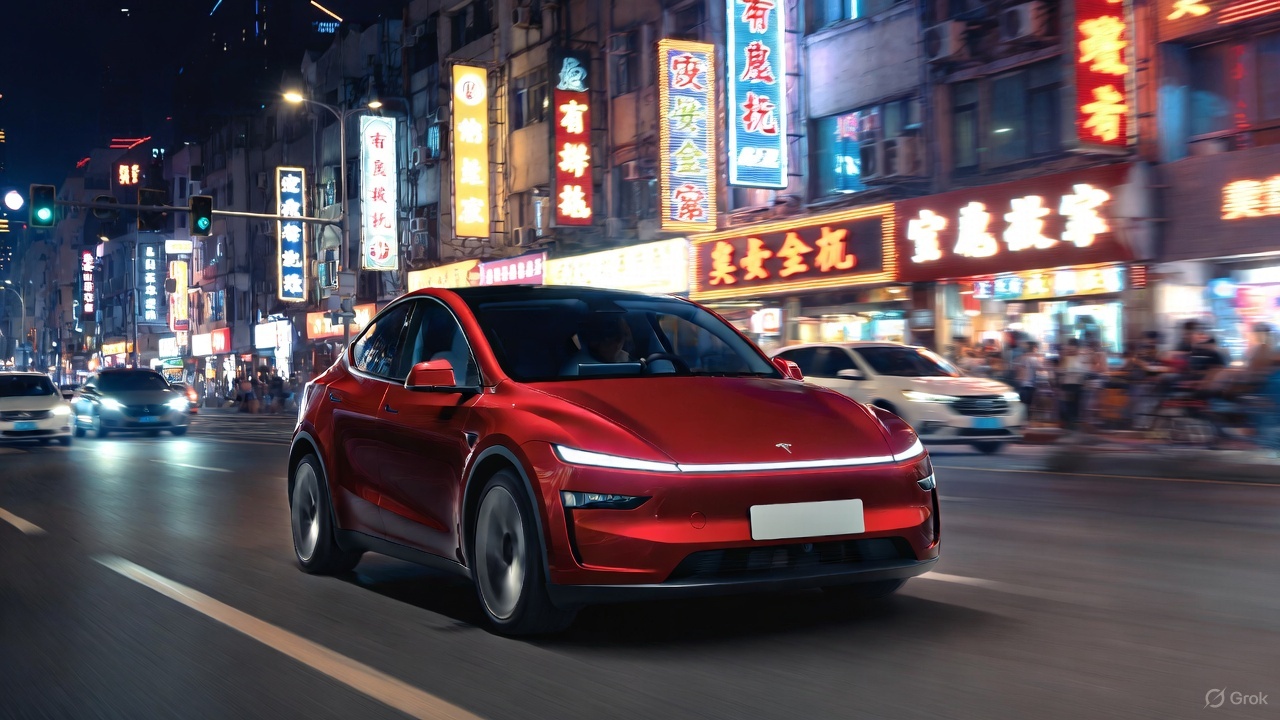
The Tesla Model Y led China’s top-selling pure electric vehicles in the 200,000–300,000 RMB segment through October 2025, as per Yiche data compiled from China Passenger Car Association (CPCA) figures.
The premium-priced SUV outpaced rivals despite a competitive field, while the Model 3 also secured an impressive position.
The Model Y is still unrivaled
The Model Y’s dominance shines in Yiche’s October report, topping the chart for vehicles priced between 200,000 and 300,000 RMB. With 312,331 units retailed from January through October, the all-electric crossover was China’s best-selling EV in the 200,000–300,000 RMB segment.
The Xiaomi SU7 is a strong challenger at No. 2 with 234,521 units, followed by the Tesla Model 3, which achieved 146,379 retail sales through October. The Model Y’s potentially biggest rival, the Xiaomi YU7, is currently at No. 4 with 80,855 retail units sold.
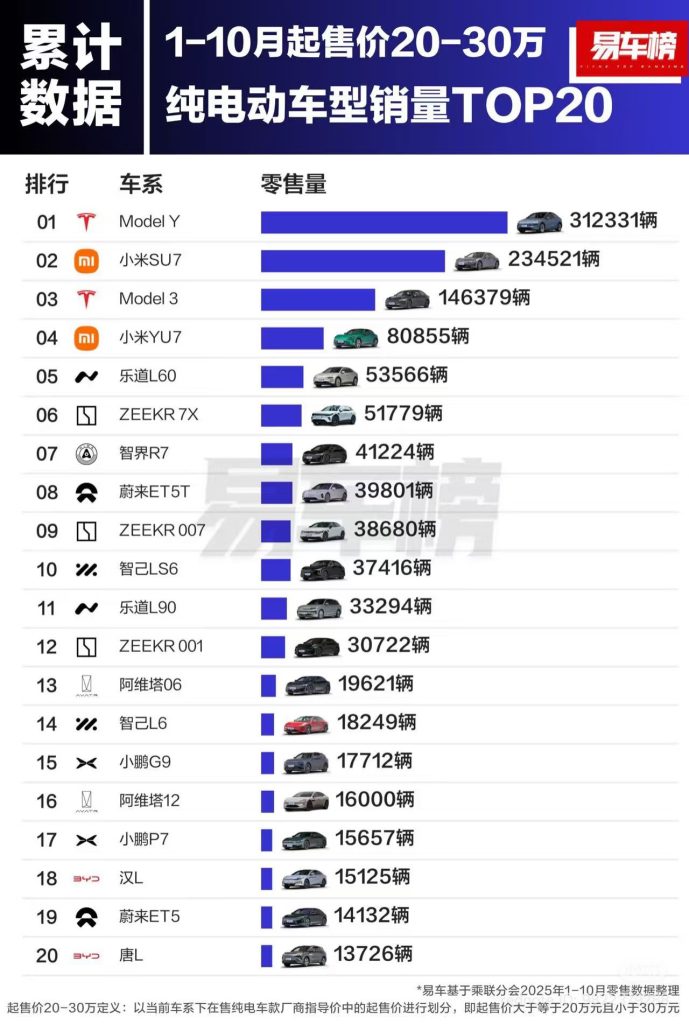
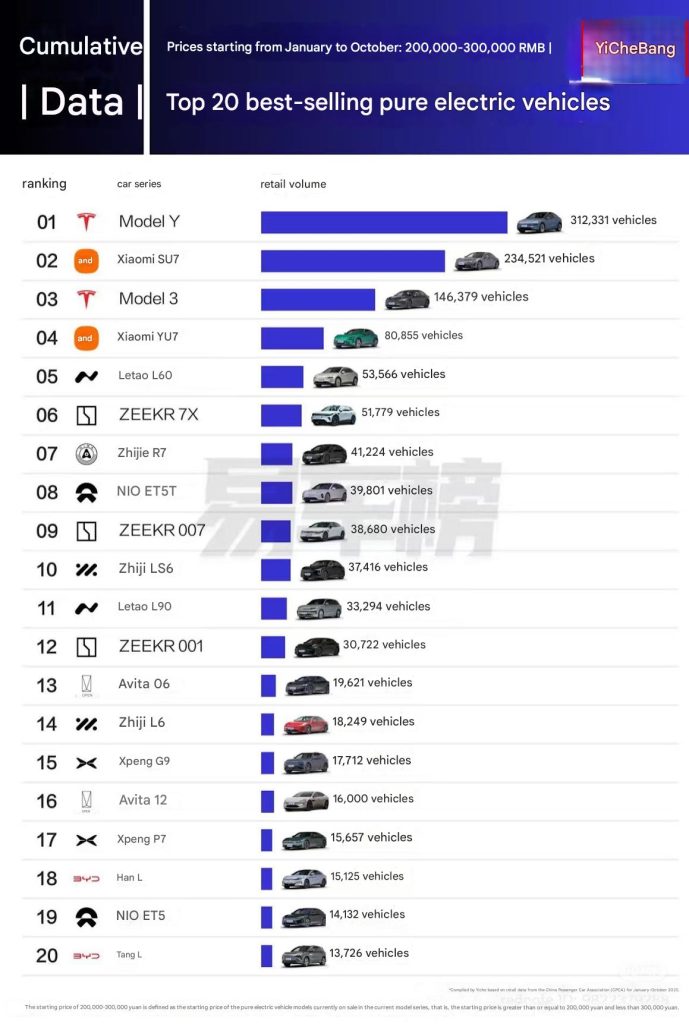
Efficiency kings
The Model 3 and Model Y recently claimed the top two spots in Autohome’s latest real-world energy-consumption test, outperforming a broad field of Chinese-market EVs under identical 120 km/h cruising conditions with 375 kg payload and fixed 24 °C cabin temperature. The Model 3 achieved 20.8 kWh/100 km while the Model Y recorded 21.8 kWh/100 km, reaffirming Tesla’s efficiency lead.
The results drew immediate attention from Xiaomi CEO Lei Jun, who publicly recognized Tesla’s advantage while pledging continued refinement for his brand’s lineup.
“The Xiaomi SU7’s energy consumption performance is also very good; you can take a closer look. The fact that its test results are weaker than Tesla’s is partly due to objective reasons: the Xiaomi SU7 is a C-segment car, larger and with higher specifications, making it heavier and naturally increasing energy consumption. Of course, we will continue to learn from Tesla and further optimize its energy consumption performance!” Lei Jun wrote in a post on Weibo.
Elon Musk
SpaceX’s Starship program is already bouncing back from Booster 18 fiasco
Just over a week since Booster 18 met its untimely end, SpaceX is now busy stacking Booster 19, and at a very rapid pace, too.
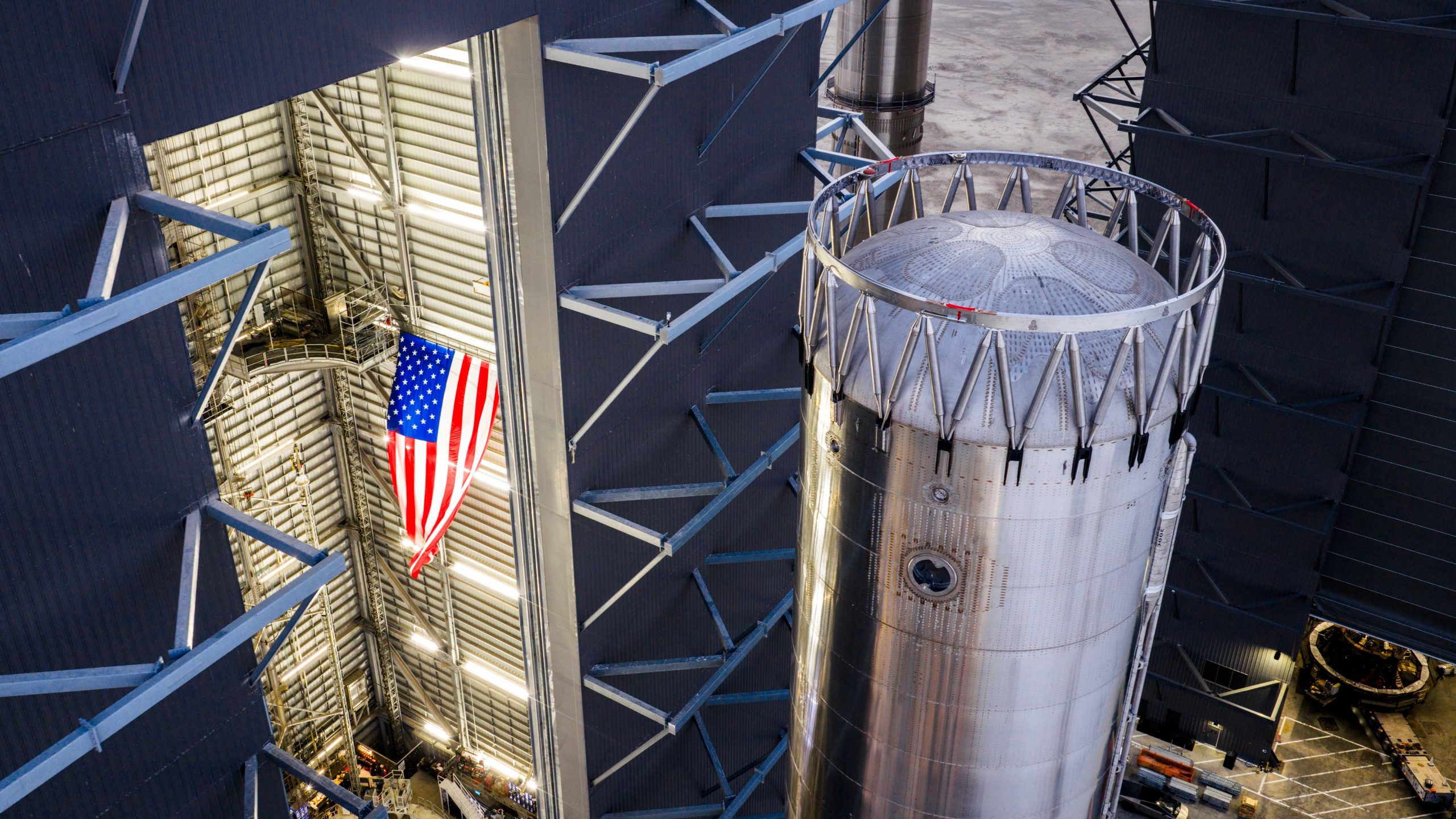
SpaceX is already bouncing back from the fiasco that it experienced during Starship Booster 18’s initial tests earlier this month.
Just over a week since Booster 18 met its untimely end, SpaceX is now busy stacking Booster 19, and at a very rapid pace, too.
Starship V3 Booster 19 is rising
As per Starbase watchers on X, SpaceX rolled out the fourth aft section of Booster 19 to Starbase’s MegaBay this weekend, stacking it to reach 15 rings tall with just a few sections remaining. This marks the fastest booster assembly to date at four sections in five days. This is quite impressive, and it bodes well for SpaceX’s Starship V3 program, which is expected to be a notable step up from the V2 program, which was retired after a flawless Flight 11.
Starship watcher TankWatchers noted the tempo on X, stating, “During the night the A4 section of Booster 19 rolled out to the MegaBay. With 4 sections in just 5 days, this is shaping up to be the fastest booster stack ever.” Fellow Starbase watcher TestFlight echoed the same sentiments. “Booster 19 is now 15 rings tall, with 3 aft sections remaining!” the space enthusiast wrote.
Aggressive targets despite Booster 18 fiasco
SpaceX’s V3 program encountered a speed bump earlier this month when Booster 18, just one day after rolling out into the factory, experienced a major anomaly during gas system pressure testing at SpaceX’s Massey facility in Starbase, Texas. While no propellant was loaded, no engines were installed, and no one was injured in the incident, the unexpected end of Booster 18 sparked speculation that the Starship V3 program could face delays.
Despite the Booster 18 fiasco, however, SpaceX announced that “Starship’s twelfth flight test remains targeted for the first quarter of 2026.” Elon Musk shared a similar timeline on X earlier this year, with the CEO stating that “ V3 is a massive upgrade from the current V2 and should be through production and testing by end of year, with heavy flight activity next year.”
Considering that Booster 19 seems to be moving through its production phases quickly, perhaps SpaceX’s Q1 2026 target for Flight 12 might indeed be more than feasible.
